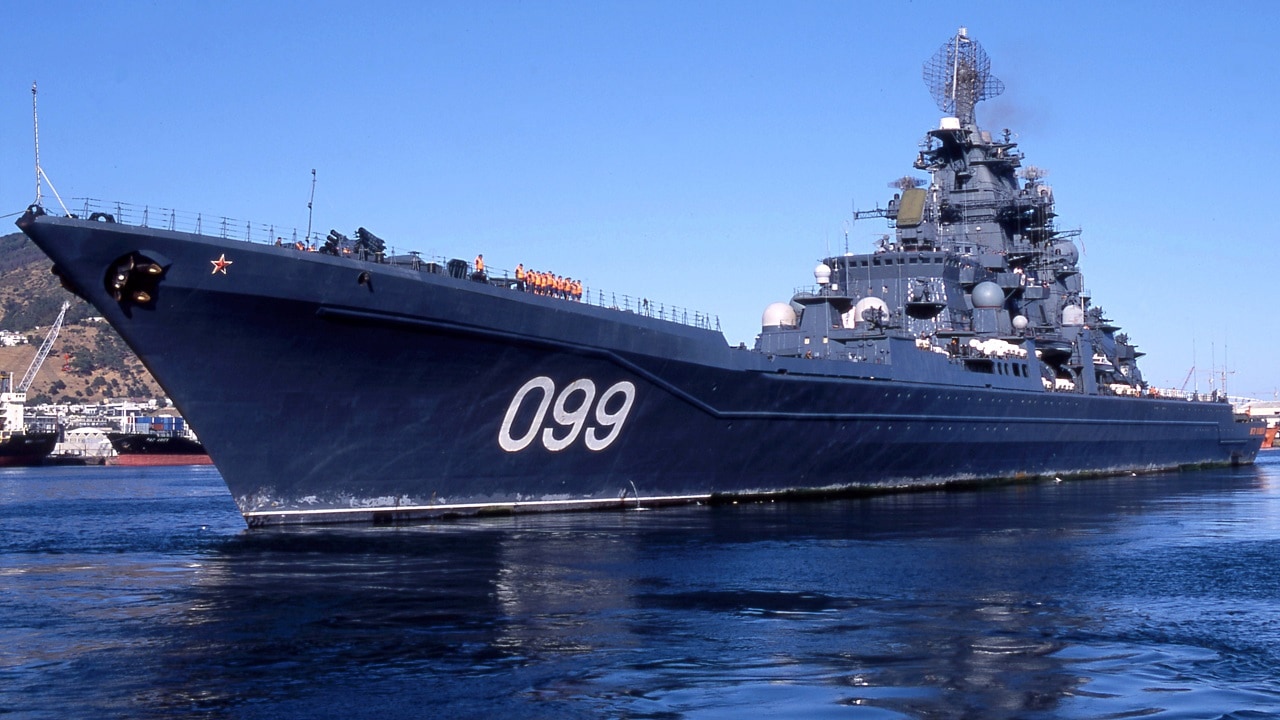Russia’s Battlecruisers – RIP? It has been more than 27 years since the last United States Navy battleship, the Iowa-class USS Missouri (BB-63), was decommissioned and stricken from the rolls. The era of the big gun battle wagons has mostly come to a close – except for some backward thinkers in the Kremlin, who continue to cling to the old ways. They apparently didn’t get the memo that such large capital warships are little more than large floating targets.
Even the sinking of the guided-missile frigate Moskva, the flagship of the Russian Navy’s Black Sea Fleet, likely have done little to change some minds within the Russian leadership.
Currently, two of the former Soviet-era Kirov-class battlecruisers remain in service with the Russian Navy, including the Pyotr Velikiy (Peter the Great) – formerly the Yuri Andropov – the flagship of the Northern Fleet; and Admiral Nakhimov, which is currently undergoing a refit.
Largest Warships
When the Soviet Union launched its Project 1144.2 missile cruiser Kirov in December 1977, at 24,401 tonnes (28,000 tons), she was the largest warship in service in the world apart from aircraft carriers. Considered reminiscent of battlecruisers from a bygone era, the new vessel was actually fairly modern.
The warship was fitted with a formidable array of sensors including air/surface search radar, fire control radar, and even hull-mounted sonar. The propulsion system was a combination of nuclear power and steam turbine, with two nuclear reactors coupled to two oil-fitted boilers, which superheated the steam produced in the reactor plant to increase the power output available during high-speed running, while it also provided an essentially unlimited range.
The main machinery was arranged in three compartments, with one compartment housing two nuclear reactors; while the other two housed the geared-turbine units and steam boilers respectively.
ASW Vessel
As the lead in a new class of vessels, Kirov was originally designed as a large ASW platform to search for and engage enemy ballistic missile submarines. It was equipped to carry three “Kamov” Ka-25 “Hormone” or Ka-27 “Helix” anti-submarine warfare (ASW) helicopters with two crews assigned to each aircraft.
The primary armament of the Kirov-class was the P-700 “Granit” (SS-N-19 “Shipwreck”) long-range anti-ship missile. A total of 20 missile launchers were installed under the upper, mounted at an angle of 60 degrees. The vertical-launch capability enables the vessels to carry out saturation missile attacks against such targets as carrier battle groups. The addition of the anti-ship missile system greatly expanded the role of the Kirov-class to engage large surface targets and to provide air and anti-submarine protection to naval forces.
Each of the missile cruisers/battlecruisers of the Kirov-class carried some 727 sailors including officers, as well as 18 additional personnel in the aircrews. As a flagship, another 15 personnel were typically assigned to the warships.
Despite the offensive capabilities of these vessels, they have been seen as a major investment for cash-strapped Moscow. As a result, at the end of the Cold War it was expected that in the event of hostilities, the Kremlin may have been reluctant to deploy any of the vessels to any waters where they could be easily attacked. Thus because of their large size, the Kirov-class battlecruisers could be seen as a wasted effort.
Simply put, it would be too vulnerable to safely be deployed in its primary role, and given that the Russian Navy lacks any vessel that could provide reasonable air cover today, that fact remains largely unchanged.
Slow Refit Efforts
Two of the four completed (of five planned) Kirov-class battlecruisers – including the lead-vessel Admiral Ushakov (ex-Kirov) and Admiral Lazarev (ex-Frunze) – were initially scheduled for refit beginning in 2010, but by 2015, it was determined the ships were beyond their service lives.
However, the third vessel, Admiral Nakhimov (ex-Kalinin) is currently undergoing a refit – but when, and more likely IF that is ever completed is now a huge question. Commissioned in 1988, she was renamed in 1992 in honor of Pavel Nakhimov, the admiral of the Imperial Russian Navy who commanded the naval and land forces during the Siege of Sevastopol during the Crimean War in the 1850s.
At this point, the warship has actually spent more time undergoing modernization than at sea, so while the potential capabilities have long been touted by Moscow, the question must be asked whether the efforts will actually pan out. By the end of the Cold War, the battlecruiser – much like her now-retired sister vessels – had rarely been deployed. She entered the Sevmash shipyard in 1997, and since 1999 has been permanently docked while waiting for the refit to be completed.
The work only began in earnest in 2013, but it was last June that the head of Russia’s United Shipbuilding Corporation Alexei Rakhmanov announced that repairs on the missile-carrying cruiser had reached the 50 percent mark. He said at the time that completion of repairs was expected by the end of 2022, but as it currently stands it could be several more years before Admiral Nakhimov is able to return to service.
While such experts have suggested it would give the Russian Navy another powerful asset, the truth is more likely that it would just be a large target that would be quickly sunk by an enemy in wartime. Perhaps she should become a floating museum instead – it would far more fitting than seeing her sunk with all hands, which is likely her fate should she ever be sortied during an armed conflict.
Now a Senior Editor for 1945, Peter Suciu is a Michigan-based writer who has contributed to more than four dozen magazines, newspapers and websites. He regularly writes about military hardware, firearms history, cybersecurity and international affairs. Peter is also a Contributing Writer for Forbes.

